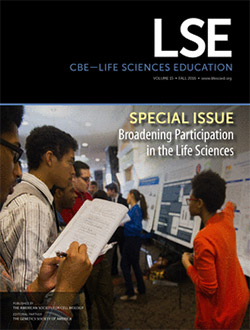NIGMS’ longstanding support of and commitment to programs that promote workforce diversity have contributed to significant progress, but persistent representation gaps along demographic lines remain in the ranks of both independent investigators and scientific leadership. These gaps lead to the loss of valuable contributors from the talent pool and limit the ability of the biomedical community to identify and address critical scientific and societal concerns. A special issue of CBE-Life Sciences Education, published September 1, provides the broader community with a chance to assess the progress made and plan for a future in which we cultivate and harness all available talent.

The papers in this issue, which I edited with Pat Marsteller of Emory University, fit four main themes:
- Innovative and effective interventions or approaches for broadening participation.
- Mechanistic explanations for why certain approaches have been effective.
- Novel insights about institutional and systemic factors that influence broadening participation efforts.
- Syntheses of research and practices that provide a “plan of action” heading forward.
NIGMS leadership, staff and grantees authored 11 of the 35 features, editorials, essays and articles in the special issue. While all of the papers focus on topics of importance to developing a diverse scientific workforce, I wanted to call your attention to a few representative articles:
- A special feature co-authored by Alison Gammie, director of NIGMS’ Division of Training, Workforce Development, and Diversity; Hannah Valantine, NIH’s chief officer of scientific workforce diversity; and P. Kay Lund, director of NIH’s Division of Biomedical Research Workforce, describes how their offices plan to integrate and coordinate efforts across NIH to catalyze enhancements in biomedical research workforce diversity. Their analysis of NIH-wide training initiatives illustrates that diversity-focused efforts are currently concentrated in early career stages, as shown in Figure 1, and underscores “the need for effective diversity efforts throughout the entire pathway” to independence.
 Figure 1. Estimate of Fiscal Year 2015 NIH Training/Career Development Participants by Career Stage and Diversity Focus. An estimate of the percentage of trainees and early career scientists in 2015 being supported by NIH through traditional training/career development programs (top right, orange) and diversity-focused training/career development programs (bottom left, blue).
Figure 1. Estimate of Fiscal Year 2015 NIH Training/Career Development Participants by Career Stage and Diversity Focus. An estimate of the percentage of trainees and early career scientists in 2015 being supported by NIH through traditional training/career development programs (top right, orange) and diversity-focused training/career development programs (bottom left, blue). - Three papers by NIGMS grantees provide mechanistic explanations for why programs such as the Postbaccalaureate Research Education Program (papers 1 and 2) and Institutional Research and Academic Career Development Awards (paper 3) produce positive outcomes for trainees. This information can be useful for others involved in student and postdoc development.
- Other work focuses on how conferences such as the NIGMS-funded Annual Biomedical Research Conference for Minority Students promote trainee development, demonstrate how engaging students’ values is important for their persistence and interest in science, and explain how the factors that influence the career decisions of Ph.D. graduates compare and contrast across race and ethnicity.
As Pat and I state in the issue’s lead editorial, “It is our vision that the results of broadening participation efforts would be a vibrant scientific enterprise that continues to harness the contributions of those from traditionally well-represented backgrounds while fostering full participation and engagement of those from other backgrounds (e.g., women, racial and ethnic minorities, people with disabilities, sexual and gender minorities, first-generation students, those from low-income backgrounds).”
Please share your feedback here or on social media using the hashtag #LifeSciDiversity.
Alison Gammie contributed to this post.

